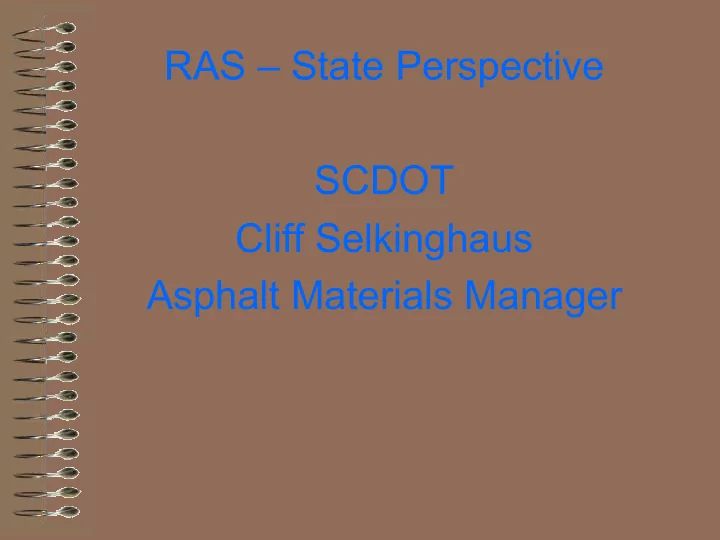

RAS – State Perspective SCDOT Cliff Selkinghaus Asphalt Materials Manager
Current Specification SC-M-407 • Use shredded shingles that are produced primarily from a shingle manufacturer-processing facility or recycled from the construction of residential or commercial roofing sites. • Use shingles that are sufficiently dry to be free flowing and to prevent foaming when blended with the hot binder. Ensure that the shingles are free of all chemicals, oils, or any other hazardous materials (e.g., asbestos).
Current Specification SC-M-407 • Only accept shredded shingles with a certification from the shingle supplier that the material conforms to these specifications. • Do not use softening agents, asphalt modifiers, rejuvenators, or recycling agents. • Samples submitted under section 3.1 may be subject to testing by SCDOT to check the recovered properties of the asphalt binder using SC-T-95, AASHTO T202 and AASHTO T316.
RAP / RAS (SC-M-407 – Section 7.0) 7. RECYCLED ASPHALT PAVEMENT OR SHINGLES MAXIMUM PERCENTAGE OF AGED BINDER Maximum % Aged Binder from RAP and RAS Type of Mix Non Fractionated RAP Fractionated RAP Surface A - 15 Surface B 15 25 Surface C 20 30 Surface CM 20 30 Surface D 20 30 Surface E - 30* PMTLSC 15 30* Intermediate A - 15 Intermediate B 20 30 Intermediate C 25 35 Base A 30 35 Base B 30 35 Base C - 35* Base D - 35* Shoulder Widening 45 *Fractionated Fine Rap only Why do we limit recycled materials? Performance! # 1 Reason – limit initial stiffness concerns & prevent premature cracking.
QC- Stockpile Management Key to Success • Shingles are permitted in HMA Aggregate Base Types A, B, C, and D, Shoulder Widening Course, Intermediate Type C, and Surface Types C, D, and E, and PMTLSC. • Utilize a maximum of 5.0% shingles, RAP may also be added, but the total percentage of aged binder will not be allowed to exceed the amount in the table.
Gradation Dry Sieve Requirements Sieve Size % Passing ½ ” 100.0 No. 4 70.0 - 95.0 No. 100 15.0 Max. No. 200 7.00 % Max AASHTO T-27 prior to ignition oven
Contractor RAS Stockpile - Good
RAS Stockpiles Dirty / Trash in Stockpiles Who gets blamed for this issue?
RAS Stockpiles Dirty / Trash in Stockpiles Who gets blamed for this issue?
Aggregates - Absorption • Dry vs. Wet
Mix Design - Production • Treat design just like any other RAP design, preheat all aggregates and add RAP/RAS approximately one hour prior to mixing in the laboratory. • Some concerns with blending in some fine graded mixes, prevent clumping and ensure adequate mixing at plant (add mixing time and more binder).
QC/QA Issues ??? RAS Summary: • Cleanliness: Free from contamination • Processing: The finer the better (coffee grind) • Processing: Stockpiles are kept dry • Design: Fine mixes are more prone to being dry, add more mixing time, and add more PG Binder. • Pavement: No significant reduction in design life witnessed (3-5% RAS) thus far.
Questions? Please feel free to contact me @ SCDOT Office and Materials & Research 1406 Shop Road, Columbia, SC (803) 737-6700 Cliff Selkinghaus
Recommend
More recommend